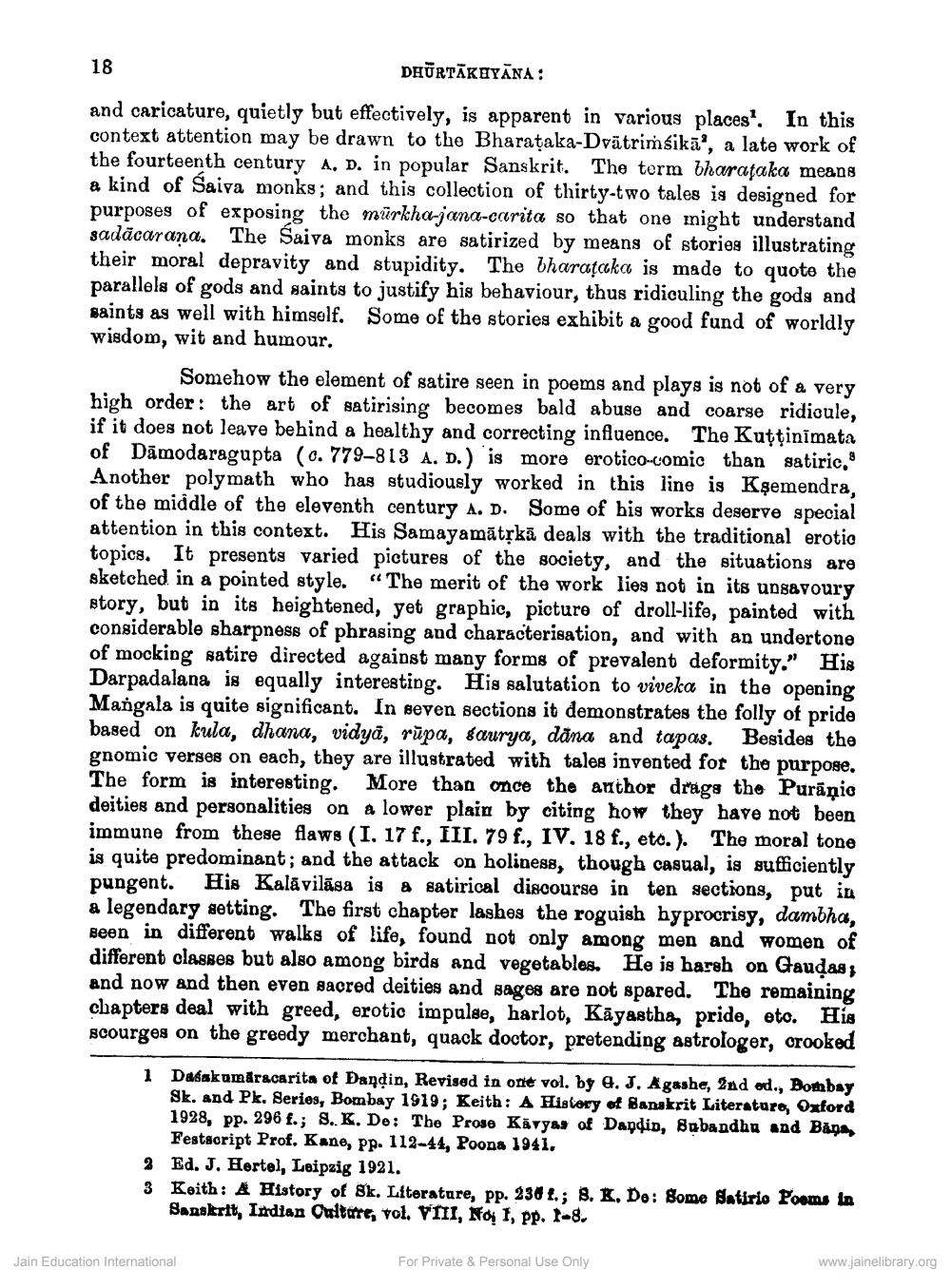________________
18
DHURTAKHYANA:
and caricature, quietly but effectively, is apparent in various places'. In this context attention may be drawn to the Bharataka-Dvätrimsika', a late work of the fourteenth century A. D. in popular Sanskrit. The term bharataka means a kind of Saiva monks; and this collection of thirty-two tales is designed for purposes of exposing the murkha-jana-carita so that one might understand sadacarana. The Saiva monks are satirized by means of stories illustrating their moral depravity and stupidity. The bharataka is made to quote the parallels of gods and saints to justify his behaviour, thus ridiculing the gods and saints as well with himself. Some of the stories exhibit a good fund of worldly wisdom, wit and humour.
Somehow the element of satire seen in poems and plays is not of a very high order: the art of satirising becomes bald abuse and coarse ridicule, if it does not leave behind a healthy and correcting influence. The Kutţinîmata of Damodaragupta (c. 779-813 A. D.) is more erotico-comic than satiric." Another polymath who has studiously worked in this line is Kşemendra, of the middle of the eleventh century A. D. Some of his works deserve special attention in this context. His Samayamātṛkā deals with the traditional erotic topics. It presents varied pictures of the society, and the situations are sketched in a pointed style. "The merit of the work lies not in its unsavoury story, but in its heightened, yet graphic, picture of droll-life, painted with considerable sharpness of phrasing and characterisation, and with an undertone of mocking satire directed against many forms of prevalent deformity." His Darpadalana is equally interesting. His salutation to viveka in the opening Mangala is quite significant. In seven sections it demonstrates the folly of pride based on kula, dhana, vidya, rupa, saurya, däna and tapas. Besides the gnomic verses on each, they are illustrated with tales invented for the purpose. The form is interesting. More than once the author drags the Purāņie deities and personalities on a lower plain by citing how they have not been immune from these flaws (I. 17 f., III. 79 f., IV. 18 f., etc.). The moral tone is quite predominant; and the attack on holiness, though casual, is sufficiently pungent. His Kalāvilasa is a satirical discourse in ten sections, put in a legendary setting. The first chapter lashes the roguish hyprocrisy, dambha, Been in different walks of life, found not only among men and women of different classes but also among birds and vegetables. He is harsh on Gaudas; and now and then even sacred deities and sages are not spared. The remaining chapters deal with greed, erotic impulse, harlot, Kayastha, pride, etc. scourges on the greedy merchant, quack doctor, pretending astrologer, crooked
His
Dadakumaracarita of Dandin, Revised in one vol. by G. J. Agashe, 2nd ed., Bombay Sk. and Pk. Series, Bombay 1919; Keith: A History of Sanskrit Literature, Oxford 1928, pp. 296 f.; S.. K. De: The Prose Kavyas of Dandin, Subandhu and Bāņa, Festscript Prof. Kane, pp. 112-44, Poons 1941.
2
Ed. J. Hertel, Leipzig 1921.
3 Keith: A History of Sk. Literature, pp. 230 f.; 8. K. De: Some Satiric Poems in Sanskrit, Indian Culture, vol. VIII, No 1, pp. 1-8.
1
Jain Education International
For Private & Personal Use Only
www.jainelibrary.org




